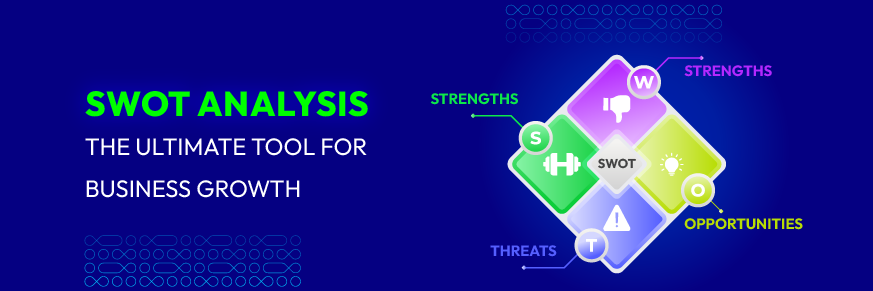From Good to Great: 10 Shopify Email Marketing Apps to Supercharge Your Store
Summer Nguyen | 01-22-2024
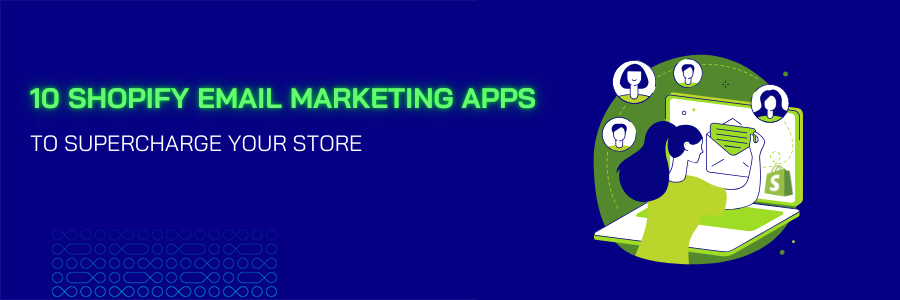
Email marketing for e-commerce sites is a digital marketing approach that uses email campaigns to advertise goods, interact with consumers, and increase revenue in the context of online retail. It is a highly effective and direct way for e-commerce businesses to communicate with their target audience, both existing customers and potential buyers.
Shopify stands out among many e-commerce platforms as a pioneer in enabling business owners to launch and expand their online ventures.
In this comprehensive guide, we will discover Shopify Email Marketing, exploring strategies and techniques to help you harness the full potential of email campaigns to boost sales and engage your customers effectively.
Whether you’re a seasoned e-commerce veteran or just starting your online journey, this guide will equip you with the knowledge and insights to push ‘send’ with confidence and drive success in the digital age.
The importance of Shopify email marketing
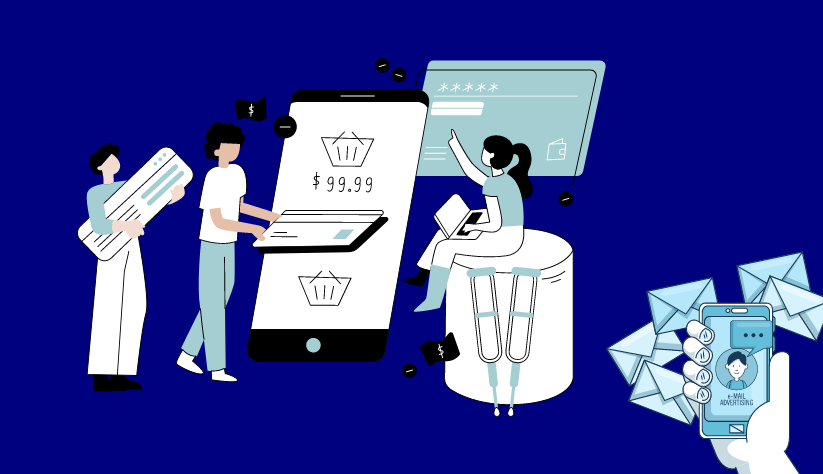
Shopify email marketing is a vital tool for online businesses, offering a direct line of communication with customers that drives sales and builds brand loyalty. Recent data underscores its significance:
- Conversion rates: According to Builwith, email marketing boasts a 4.29% conversion rate, outperforming other channels like social media and search. This means for every 100 emails sent, nearly 4 result in a purchase.
- Revenue generation: In a study by Omnisend, it was found that email marketing contributes to 20% of all Shopify sales, making it a substantial revenue driver for merchants on the platform.
- Customer engagement: Personalized email campaigns have been shown to increase engagement rates by up to 74%, as reported by Campaign Monitor. Tailored messages resonate with recipients, leading to higher open and click-through rates.
- Automation efficiency: With Shopify’s built-in email automation features, merchants can easily set up triggered emails for abandoned carts, welcome sequences, and product recommendations. These automated campaigns ensure timely communication with customers, boosting retention and sales.
- Cost-effectiveness: Compared to other marketing channels, email campaigns are relatively inexpensive to execute, offering an impressive return on investment. According to Luisazhou, every dollar spent on email marketing yields an average return of $42.
Top 10 Best Shopify Email Marketing Apps You Should Know
Here are the top 10 best Shopify email marketing apps you should consider:
App Name |
Key Features |
Pricing |
Best Suited For |
Rating |
|---|---|---|---|---|
Shopify Email |
Native Shopify integration, drag-and-drop editor, personalized emails |
Free for first 10,000 emails/month, $1 per 1,000 additional emails |
Small to medium-sized businesses prioritizing ease of use |
4.6/5 |
Omnisend |
Omnichannel campaigns (email, SMS, push), automation workflows, segmentation |
Free plan, Standard: $16/month, Pro: $59/month |
Mid-sized to large eCommerce businesses |
4.7/5 |
Klaviyo |
Advanced analytics, segmentation, A/B testing, data-driven approach |
Free plan for up to 250 contacts, Paid plans from $20/month |
Growing eCommerce businesses seeking advanced analytics |
4.7/5 |
Yotpo Email Marketing |
Leverages reviews and UGC, integrates loyalty programs and SMS marketing |
Free for up to 50 orders/month, Paid plans from $19/month |
Businesses focusing on social proof and customer loyalty |
4.9/5 |
Privy ‐ Pop Ups, Emails, & SMS |
Combines pop-ups, email, and SMS marketing; list-building tools |
Free plan, Starter: $15/month, Growth: $45/month |
Small businesses/startups focused on lead generation |
4.6/5 |
Seguno Email Marketing |
Operates within Shopify dashboard, automation, discount codes |
Free for up to 250 subscribers, Premium from $10/month |
Small and medium-sized businesses preferring Shopify integration |
4.8/5 |
EcomSend Pop Ups, Email Popups |
Customizable pop-ups, advanced targeting, lead generation |
Free plan, Premium from $9/month |
Merchants focused on reducing cart abandonment rates |
5/5 |
CM Commerce: Email Marketing |
Automation workflows, product reviews integration, analytics |
14-day free trial, Paid plans from $9/month |
eCommerce businesses prioritizing customer feedback |
4.7/5 |
Sendvio: Email Marketing & SMS |
Email & SMS marketing, multilingual support, dynamic discount codes |
Free plan, Premium from $11/month |
eCommerce stores with international audiences |
4.9/5 |
Avada Email Marketing |
Email & SMS marketing, automation workflows, dynamic discount codes |
Free plan, Premium from $9/month |
Businesses looking for automation and scalability |
4.9/5 |
1. Shopify Email
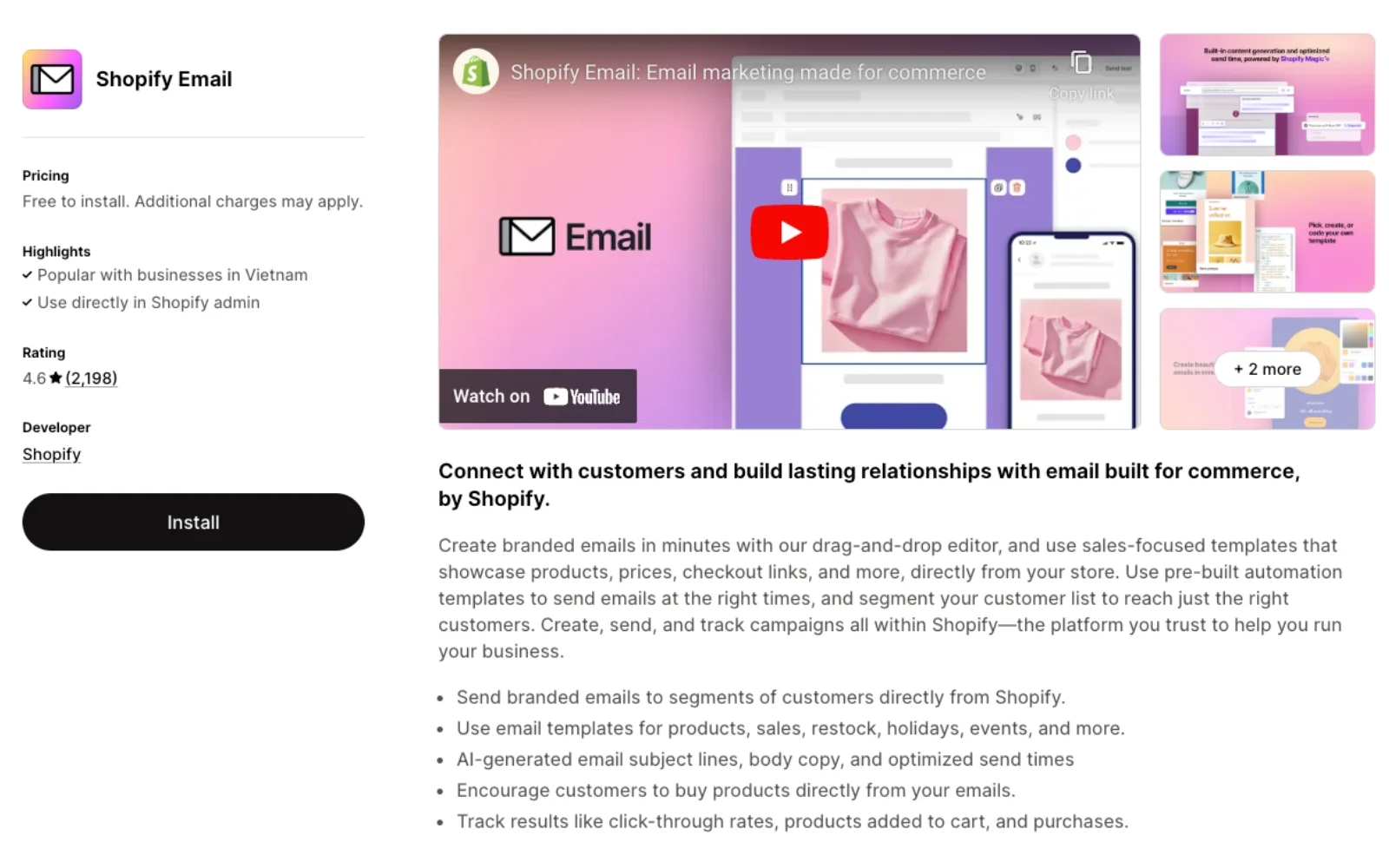
Shopify Email is Shopify’s native email marketing solution, providing seamless integration and ease of use for Shopify store owners. This app enables merchants to craft and manage email campaigns directly from the Shopify dashboard, eliminating the need for third-party integrations. With Shopify Email, merchants can send promotional emails, newsletters, and product updates effortlessly. The drag-and-drop editor simplifies the process of creating visually appealing emails that match your brand’s identity, ensuring consistent communication with your audience.
One of the most notable features of Shopify Email is its integration with Shopify’s customer data. It allows merchants to use store data to personalize emails, including product recommendations based on purchase history. This level of personalization helps increase customer engagement and conversion rates.
The pricing model is straightforward and budget-friendly. The first 10,000 emails sent each month are free, making it an excellent option for small businesses. Beyond that, Shopify charges $1 for every 1,000 additional emails sent, which is far more affordable compared to many third-party Shopify email marketing apps.
Shopify Email is best suited for small to medium-sized businesses that prioritize ease of use and seamless integration. It’s particularly beneficial for beginners and merchants who prefer to avoid complex setups. Store owners who want a basic yet reliable email marketing tool without the hassle of third-party services will find Shopify Email a perfect fit.
Rating: 4.6/5
2. Omnisend

Omnisend is a feature-rich Shopify email marketing app designed to help businesses create comprehensive omnichannel marketing campaigns. It offers more than just email marketing; it includes SMS marketing, push notifications, and advanced automation workflows. This app integrates with Shopify to provide a seamless experience in managing customer interactions across multiple channels.
What makes Omnisend stand out from other Shopify email marketing apps is its pre-built automation workflows. These workflows cover key customer touchpoints such as welcome series, cart abandonment reminders, and post-purchase follow-ups. Users can also build custom workflows to suit their unique business needs. The app’s segmentation feature allows merchants to target specific customer groups based on their behavior, increasing the relevance of their messages.
Omnisend offers a free plan that includes up to 500 emails per month and access to basic automation features. For businesses needing more robust functionality, the Standard plan starts at $16 per month and includes unlimited emails, SMS credits, and advanced reporting. The Pro plan, starting at $59 per month, provides even more comprehensive tools, including personalized product recommendations and priority support.
Omnisend is ideal for mid-sized to large eCommerce businesses looking to scale their email marketing efforts and incorporate multiple channels into their campaigns. It’s perfect for merchants who want to engage customers through personalized messages and drive conversions using data-driven strategies.
Rating: 4.7/5
3. Klaviyo

Klaviyo is one of the most powerful Shopify email marketing apps, known for its data-driven approach to customer engagement. It integrates seamlessly with Shopify, allowing merchants to gather customer data and use it to create highly personalized email campaigns. Klaviyo provides tools for segmentation, automation, and analytics, making it an all-in-one solution for email marketing.
Unlike other Shopify email marketing apps, Klaviyo offers advanced analytics and reporting features that give merchants deep insights into their campaigns’ performance. Users can track revenue generated from email campaigns, open rates, click-through rates, and more. This information helps merchants optimize their strategies and improve ROI. Additionally, Klaviyo’s A/B testing capabilities allow businesses to experiment with different email formats and subject lines to identify what works best.
Klaviyo’s pricing starts with a free plan for up to 250 contacts and 500 emails per month. Paid plans are tiered based on the number of contacts, with pricing starting at $20 per month for larger lists. The cost increases as your contact list grows, making it more suitable for established businesses with a significant customer base.
Klaviyo is best suited for data-driven marketers and growing eCommerce businesses that want to maximize their email marketing ROI. It’s ideal for stores that need advanced analytics and personalization features to boost customer engagement and conversions.
Rating: 4.7/5
4. Yotpo Email Marketing

Yotpo Email Marketing focuses on leveraging customer reviews and user-generated content (UGC) to enhance email campaigns. This app allows merchants to collect and showcase reviews, ratings, and photos within their email communications, adding a layer of trust and social proof. Yotpo’s integration with Shopify makes it easy to personalize emails by incorporating product recommendations and review requests based on customer behavior.
What makes Yotpo stand out from other Shopify email marketing apps is its all-in-one approach. It combines email marketing with loyalty programs, SMS marketing, and UGC management. This comprehensive solution helps businesses strengthen customer relationships and drive repeat purchases. The app’s automated workflows ensure that customers receive timely emails, such as thank-you messages and review requests.
Yotpo offers a free plan for businesses with up to 50 monthly orders. Paid plans start at $19 per month and provide more advanced features, including SMS marketing, loyalty programs, and customizable email templates.
Yotpo Email Marketing is ideal for businesses that rely heavily on customer reviews and social proof to drive sales. It’s an excellent choice for brands focused on building long-term customer loyalty through personalized communication and engagement.
Rating: 4.9/5
5. Privy ‐ Pop Ups, Emails, & SMS
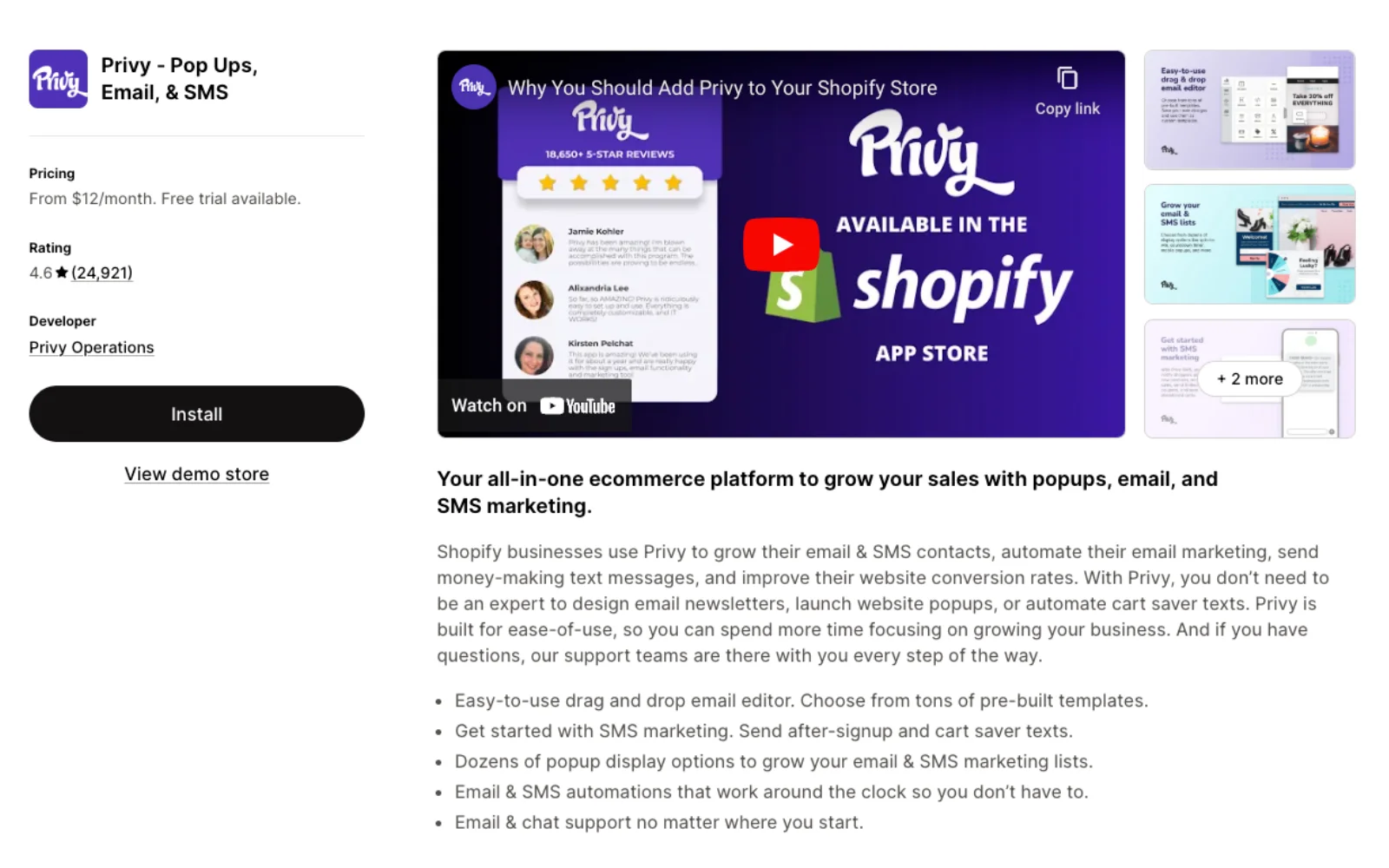
Privy is a versatile Shopify email marketing app that combines email marketing, pop-ups, and SMS marketing into one platform. It focuses on helping merchants grow their email lists and engage customers throughout their buying journey. Privy integrates seamlessly with Shopify, allowing users to create custom pop-ups, banners, and embedded forms to capture leads.
What sets Privy apart is its emphasis on list-building tools. The app offers a variety of pop-up templates, targeting options, and exit-intent pop-ups to capture customer emails before they leave the site. Privy also includes email marketing features for sending promotional campaigns and follow-up emails. The SMS marketing feature further enhances customer engagement by reaching them on their mobile devices.
Privy’s free plan includes pop-ups and basic email capture forms. The Starter plan starts at $15 per month and includes email marketing capabilities. The Growth plan, starting at $45 per month, offers more advanced features such as SMS marketing and A/B testing.
Privy is best suited for small businesses and startups that want an all-in-one solution for email marketing and lead generation. It’s perfect for merchants who prioritize growing their subscriber lists and engaging potential customers through targeted campaigns.
Rating: 4.6/5
6. Seguno Email Marketing

Seguno Email Marketing is a Shopify-exclusive app designed to make email marketing simple and efficient. It stands out for its ability to operate directly within the Shopify dashboard, eliminating the need for users to manage multiple platforms. With Seguno, merchants can create and automate email campaigns quickly using pre-built templates and workflows that require minimal customization.
Seguno focuses heavily on automation to help merchants engage with their customers at the right time. The app includes welcome emails, post-purchase follow-ups, and abandoned cart recovery messages as part of its core automation offerings. One of Seguno’s unique features is its ability to convert discount codes into personalized email content, encouraging more conversions.
Pricing for Seguno is straightforward. There’s a free plan available for up to 250 subscribers, and the premium plan starts at $10 per month for additional subscribers. Unlike many other Shopify email marketing apps, Seguno’s pricing is designed to grow with the store’s needs without overwhelming merchants with hidden costs.
Seguno is best suited for small and medium-sized businesses that want an easy-to-use, automated email marketing solution. It’s ideal for merchants who prefer to manage all their marketing efforts within Shopify without dealing with complex integrations.
Rating: 4.8/5
7. EcomSend Pop Ups, Email Popups
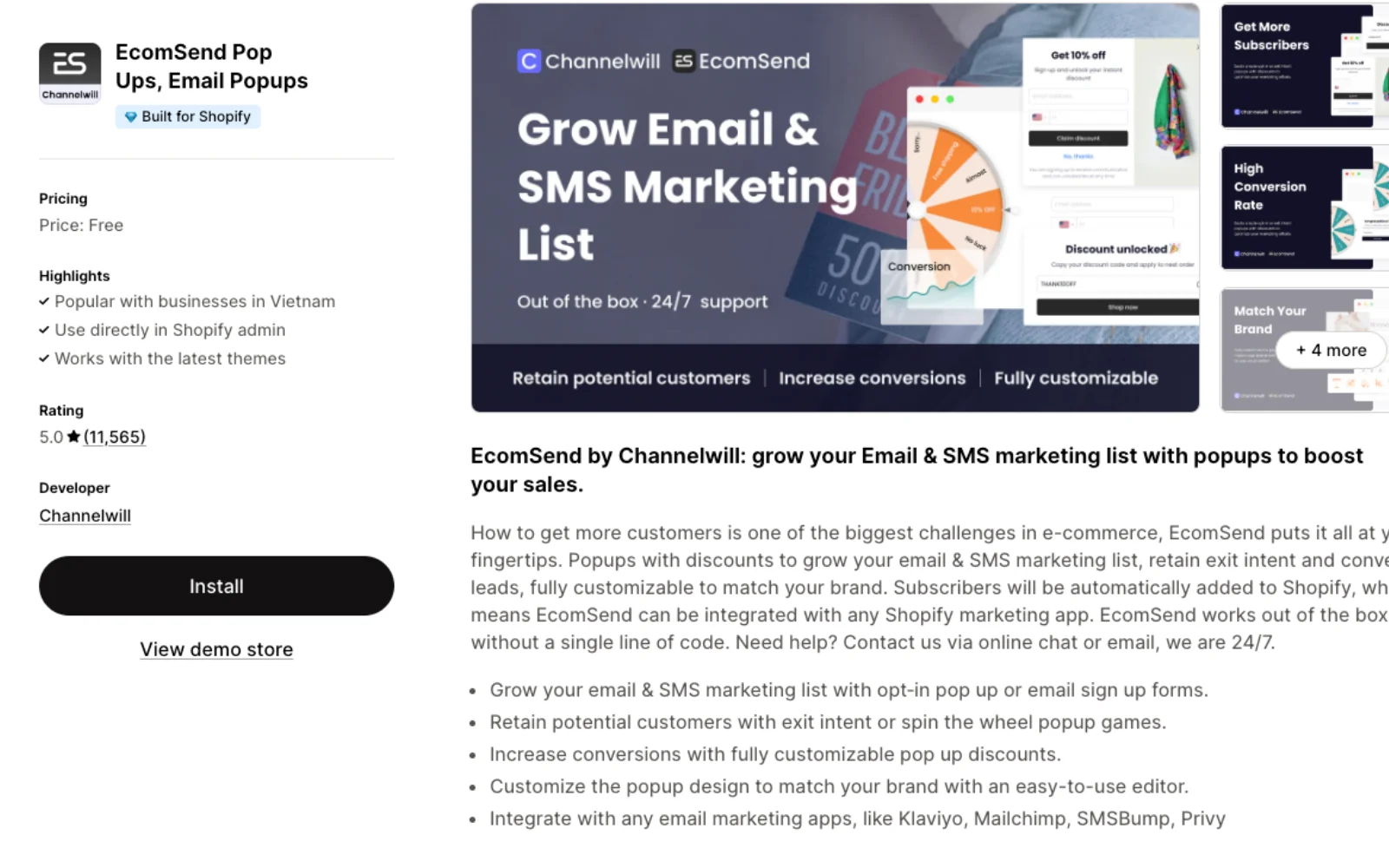
EcomSend focuses on helping merchants grow their email lists through customizable pop-ups and email capture forms. The app provides a variety of pre-designed templates that merchants can tailor to fit their brand’s aesthetics. EcomSend integrates seamlessly with Shopify and allows users to set up exit-intent pop-ups, discount offers, and other lead-generation tools.
What makes EcomSend unique compared to other Shopify email marketing apps is its advanced targeting and triggering options. Merchants can set specific conditions for when and where pop-ups should appear based on user behavior. This ensures that visitors are engaged at the right moments, increasing the likelihood of conversions. EcomSend also includes built-in analytics to help store owners track performance and optimize their lead-capture strategy.
EcomSend offers a free plan with essential features, while premium plans start at $9 per month. The affordable pricing makes it an attractive option for businesses of all sizes that are focused on growing their subscriber lists.
EcomSend is perfect for merchants who want to reduce cart abandonment rates and increase conversions by capturing leads effectively. It’s especially useful for stores that need to engage visitors before they leave the website.
Rating: 5/5
8. CM Commerce: Email Marketing

CM Commerce is an email marketing solution designed specifically for eCommerce businesses. It offers a range of automation workflows, including cart abandonment recovery, product review requests, and personalized follow-up emails. The app integrates smoothly with Shopify, allowing merchants to send targeted emails based on customer behavior and purchase history.
One of CM Commerce’s standout features is its focus on customer feedback. The app makes it easy for merchants to collect and showcase product reviews within their email campaigns, building trust and encouraging repeat purchases. Additionally, CM Commerce provides detailed reporting and analytics to help merchants track the effectiveness of their email marketing efforts.
CM Commerce offers a 14-day free trial for new users. After the trial period, pricing starts at $9 per month for basic plans, with more advanced plans available for larger stores that require more features.
CM Commerce is suitable for eCommerce businesses that want to automate their email marketing while focusing on customer reviews and feedback. It’s an excellent choice for merchants looking to improve customer engagement and increase conversions through personalized and automated email campaigns.
Rating: 4.7/5
9. Sendvio: Email Marketing & SMS

Sendvio is a powerful Shopify email marketing app that combines email and SMS marketing to create a comprehensive communication platform for eCommerce businesses. It offers pre-built automation workflows, including abandoned cart recovery, welcome series, and post-purchase follow-ups, helping merchants stay connected with their customers at key touchpoints.
What makes Sendvio unique among Shopify email marketing apps is its multilingual support and cross-channel marketing capabilities. The app allows merchants to send campaigns in multiple languages, making it an ideal solution for stores with a global audience. Sendvio also includes features like dynamic discount codes, product recommendations, and advanced segmentation to personalize customer interactions.
Sendvio offers a free plan that includes essential email and SMS marketing features. The Premium plan starts at $11 per month, providing access to more advanced automation workflows and unlimited emails. The app also offers pay-as-you-go SMS credits, allowing businesses to control their messaging costs.
Sendvio is best suited for eCommerce stores looking to engage customers across multiple channels, especially those with international audiences. It’s perfect for merchants who want a versatile and scalable solution to manage both email and SMS marketing from a single platform.
Rating: 4.9/5
10. Avada Email Marketing

Avada Email Marketing is a comprehensive solution designed to help Shopify merchants automate their email marketing campaigns and boost customer engagement. This app combines email marketing, SMS marketing, and various automation workflows to create a robust marketing platform. Avada offers a user-friendly interface and a wide range of templates, making it easy for merchants to set up and manage campaigns without technical expertise.
One of Avada’s unique selling points is its extensive library of pre-built automation workflows. These workflows include welcome series, abandoned cart recovery, post-purchase follow-ups, and more. The app also provides advanced segmentation and personalization features, allowing merchants to tailor their messages based on customer behavior and preferences. Additionally, Avada offers dynamic discount codes and product recommendations, helping merchants increase conversions and drive repeat purchases.
Avada’s pricing model is one of its strengths. The app offers a free plan that includes basic email marketing features and automation workflows. Premium plans start at $9 per month, providing access to more advanced features, including unlimited emails, SMS credits, and priority support. This pricing structure makes Avada an affordable yet powerful option for businesses of all sizes.
Avada Email Marketing is best suited for eCommerce businesses looking for a feature-rich and cost-effective email marketing solution. It’s ideal for merchants who want to leverage automation to engage customers, recover lost sales, and build lasting relationships. With its intuitive interface and wide range of features, Avada is perfect for both small businesses and larger enterprises seeking to scale their marketing efforts.
Rating: 4.9/5
Conclusion
In conclusion, email marketing stands as a cornerstone of success for e-commerce businesses, particularly those leveraging the power of Shopify. By strategically implementing the ten essential Shopify email marketing strategies outlined in this article, you equip yourself with a potent toolkit to engage, convert, and retain customers in the ever-evolving digital marketplace.
Your email campaigns serve as more than just promotional tools; they are the bridge that connects your brand with your audience, conveying your unique value proposition and nurturing lasting customer relationships. In the age of data-driven marketing, analytics, and metrics are your guiding stars, enabling you to refine your approach and achieve increasingly impressive results.






